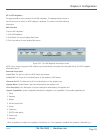
724-746-5500 | blackbox.com
724-746-5500 | blackbox.com
Page 97
Chapter 3: Configuration
• Apartment: Unit (Apartment, suite) - Example: Apt 42.
• Floor: Floor - Example: 4.
• Room no.: Room number - Example: 450F.
• Place type: Place type - Example: Office.
• Postal community name: Example: Leonia.
• P.O. Box: Post office box (P.O. BOX) - Example: 12345.
• Additional code: Example: 1320300003.
• Emergency Call Service: (e.g. E911 and others), such as defined by TIA or NENA.
• Emergency Call Service: Emergency Call Service ELIN identifier data format is defined to carry the ELIN identifier as used
during emergency call setup to a traditional CAMA or ISDN trunk-based PSAP. This format consists of a numerical digit string,
corresponding to the ELIN to be used for emergency calling.
Parameter Configuration: Policies
Network Policy Discovery enables the efficient discovery and diagnosis of mismatch issues with the VLAN configuration, along
with the associated Layer 2 and Layer 3 attributes, which apply for a set of specific protocol applications on that port. Improper
network policy configurations are a very significant issue in VoIP environments that frequently result in voice quality degradation
or loss of service. Policies are only intended for use with applications that have specific “real-time“ network policy requirements,
such as interactive voice and/or video services.
The network policy attributes advertised are:
1. Layer 2 VLAN ID (IEEE 802.1Q-2003)
2. Layer 2 priority value (IEEE 802.1D-2004)
3. Layer 3 Diffserv code point (DSCP) value (IETF RFC 2474)
This network policy is potentially advertised and associated with multiple sets of application types supported on a given port. The
application types specifically addressed are:
1. Voice
2. Guest Voice
3. Softphone Voice
4. Videoconferencing
5. Streaming Video
6. Control / Signaling (conditionally support a separate network policy for the media types above)
A large network may support multiple VoIP policies across the entire organization and different policies per application type.
LLDP-MED allows multiple policies to be advertised per port, each corresponding to a different application type. Different ports
on the same network connectivity device may advertise different sets of policies, based on the authenticated user identity or port
configuration.
NOTE: LLDP-MED is not intended to run on links other than between network connectivity devices and endpoints, and therefore
does not need to advertise the multitude of network policies that frequently run on an aggregated link interior to the LAN.
• Delete: Check to delete the policy. It will be deleted during the next save.
• Policy ID: ID for the policy. This is auto generated and should be used when selecting the polices that are mapped to the
specific ports.
LGB1108A


















